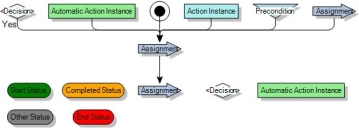Assignments
For management purposes, you need to ensure that each process is constantly visible so that people can access each action. This means that you need to assign your process to at least one user, group or role throughout its lifecycle. You can set up automatic or manual assignments.
A single process can have only one assignment at a time. However, a process can have many tasks running concurrently, each with their own assignment. You can modify and complete assignments, or reassign them to other roles, groups and users.
Creating an automatic assignment
Automatic assignments enable you to set up in advance the specific role, group or user who will administer a particular stage of a process. This gives you greater control over the process.
Automatic assignments have the following process rules:
- An automatic assignment can exist as the end node of many connections. These can be from the start point, decisions, assignments, preconditions, actions or automatic actions.
- An automatic assignment can have only one forward connection. This is either to a status, an assignment, a decision, or an automatic action.
To create an automatic assignment:
- In Process Designer, open the relevant process.
- Expand the Toolbox (
 ).
). - Drag an Assignment onto the workspace.
The Assignment window appears. - Complete the relevant information, then click OK.
The automatic assignment is set up, and each time the process reaches this stage, an assignment is sent to the required user or group. - Click
 .
.
Manual assignments
Manual assignments enable users to specify who will administer the next stage of a process. You can set up the Assignment window to appear automatically when required.
You can make the assignment mandatory by designing the process so that assignment is the only available action at a specific stage in the process. This means that the current user cannot continue until they have completed the assignment.
To create a manual assignment:
- In the Process Designer component, open the relevant process.
- Expand the Toolbox (
 ).
). - Drag an Action Instance onto the workspace.
The Select Action dialog appears. - Select Assign (or whatever name you have given for assignments), then click OK.
- If you want the window of that action to appear, then in the Properties grid, alongside Is autoprompt action instance, select True.
- Click
 .
.
